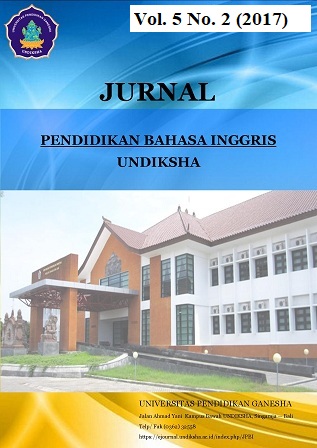AN ANALYSIS OF MAXIM VIOLATION TO ACHIEVE POLITENESS IN TEACHERS UTTERANCES OF SMPN 3 SINGARAJA IN ACADEMIC YEAR OF 2017/2018
DOI:
https://doi.org/10.23887/jpbi.v5i2.15067Abstract
One of the ideal purposes of communication is giving information, but sometimes information is delivered in certain condition to make another intention. The violation of such ideals then occurred based on one’s reason and can be observed by looking at the available context. Of all the reasons behind maxim violation, politeness is one of them. It is an essential part of communication which could maintain a good relationship between both speaker and hearer. Teacher is one of the essential parts in education sector. In teaching and learning process, teacher sometimes violate the maxim to imply a more encouraging yet polite responses. In this study, the writer had combined two variables of pragmatics study which occurred in the ground of educational sector. In this study, the writer had combined two variables of pragmatics study which occurred in the ground of educational sector. The writer then tried to define the way on how Mrs. AS, one of the English teachers in SMPN 3 Singaraja violates the maxim and also its relation with politeness. Videos of teaching and learning process had been taken and transcribed to provide an authentic data. The result of the data shows that 229 utterances had violated maxim while achieving politeness at the same time. In conclusion, violating a maxim could be based on one simple yet noble reason: politeness.Kata Kunci : maxim violation, politeness, Cooperative Principle, teacher, utterance
One of the ideal purposes of communication is giving information, but sometimes information is delivered in certain condition to make another intention. The violation of such ideals then occurred based on one’s reason and can be observed by looking at the available context. Of all the reasons behind maxim violation, politeness is one of them. It is an essential part of communication which could maintain a good relationship between both speaker and hearer. Teacher is one of the essential parts in education sector. In teaching and learning process, teacher sometimes violate the maxim to imply a more encouraging yet polite responses. In this study, the writer had combined two variables of pragmatics study which occurred in the ground of educational sector. In this study, the writer had combined two variables of pragmatics study which occurred in the ground of educational sector. The writer then tried to define the way on how Mrs. AS, one of the English teachers in SMPN 3 Singaraja violates the maxim and also its relation with politeness. Videos of teaching and learning process had been taken and transcribed to provide an authentic data. The result of the data shows that 229 utterances had violated maxim while achieving politeness at the same time. In conclusion, violating a maxim could be based on one simple yet noble reason: politeness.
keyword : maxim violation, politeness, Cooperative Principle, teacher, utterance
Published
2018-07-26
Issue
Section
Articles
License
Authors who publish with the Jurnal Pendidikan Bahasa Inggris Undiksha agree to the following terms:- Authors retain copyright and grant the journal the right of first publication with the work simultaneously licensed under a Creative Commons Attribution License (CC BY-SA 4.0) that allows others to share the work with an acknowledgment of the work's authorship and initial publication in this journal
- Authors are able to enter into separate, additional contractual arrangements for the non-exclusive distribution of the journal's published version of the work (e.g., post it to an institutional repository or publish it in a book), with an acknowledgment of its initial publication in this journal.
- Authors are permitted and encouraged to post their work online (e.g., in institutional repositories or on their website) prior to and during the submission process, as it can lead to productive exchanges, as well as earlier and greater citation of published work. (See The Effect of Open Access)













